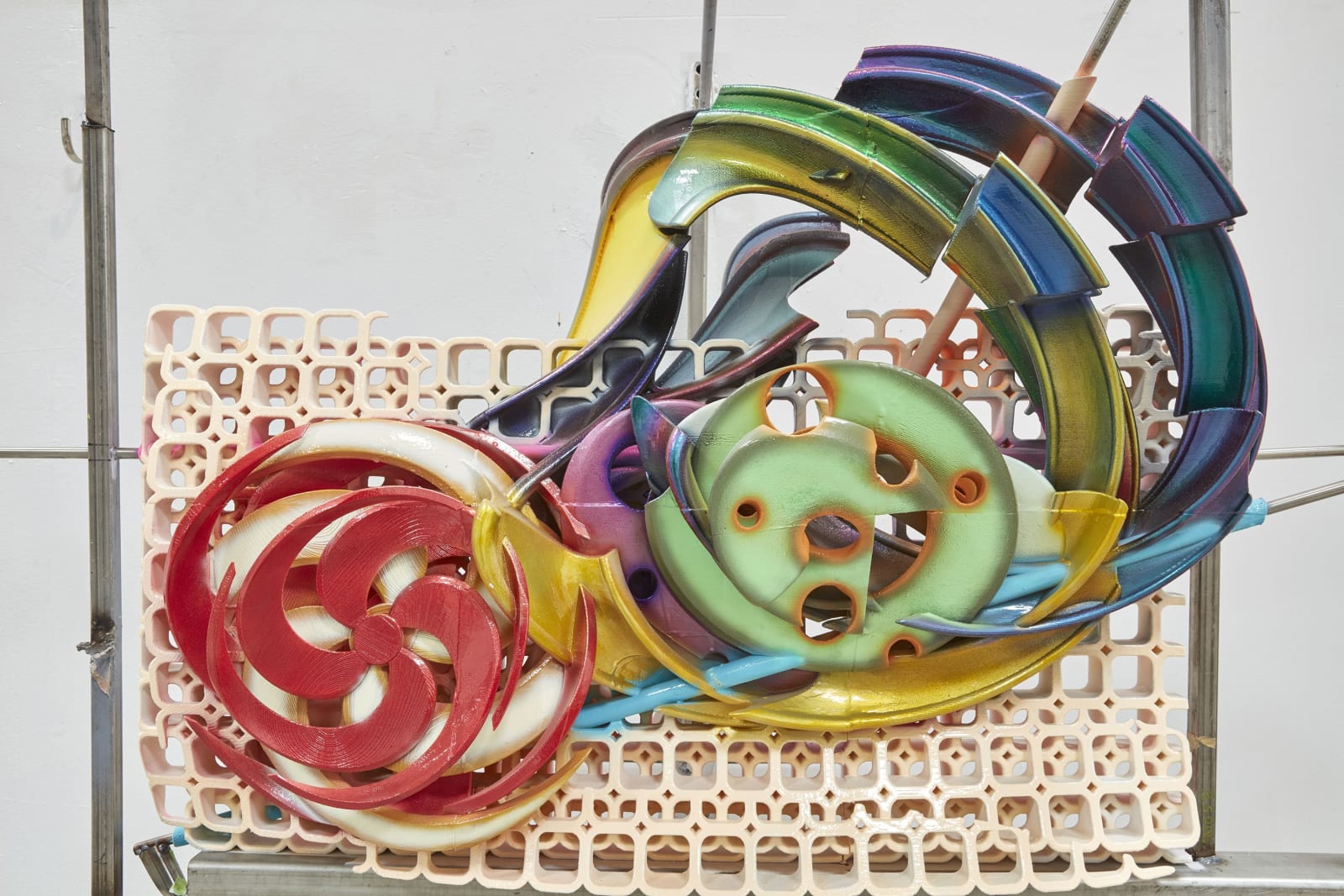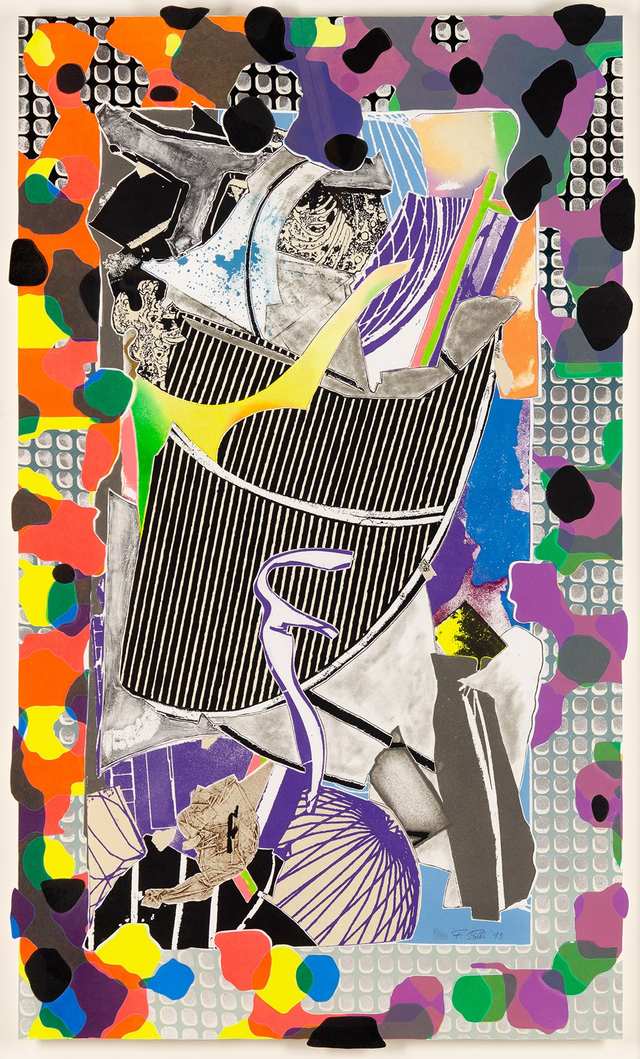
Frank Stella
Frank Stella is an American artist renowned for his significant contributions to the art world, particularly in the field of Minimalism and post-painterly abstraction.
Biography of Frank Stella
Frank Stella was born in 1936 in Malden, Massachusetts. After attending Phillips Academy in Andover, Massachusetts, he enrolled at Princeton University.
In 1959, a selection of his paintings found their way into two prominent exhibitions: "Three Young Americans," held at the Allen Memorial Art Museum at Oberlin College, and "Sixteen Americans," showcased at the Museum of Modern Art in New York in 1960.
In 1960, Frank Stella's artworks began to incorporate shaped canvases, which later evolved into intricate designs, culminating in the renowned "Irregular Polygon" series. Later, he embarked on his acclaimed "Protractor Series" (1971), featuring paintings with intersecting arcs, often within square boundaries, named after circular cities he had visited in the Middle East in the 1960s.
In 1967, Frank Stella was responsible for designing the set and costumes for "Scramble," a dance piece choreographed by Merce Cunningham. In 1970, Stella's work was showcased in a retrospective at The Museum of Modern Art in New York.
Between 1978 and 2005, Stella utilized the Van Tassell and Kearney Horse Auction Mart building in Manhattan's East Village as his studio. However, after 2005, he divided his time between his West Village apartment and a studio in Newburgh, New York.
In 1984, Stella delivered the Charles Eliot Norton Lectures, advocating for a revival of abstraction and aspiring to achieve the depth found in Baroque painting. Harvard University Press published these six insightful lectures in 1986 under the title "Working Space."
Currently, the artist works and lives in New York city, USA.
Frank Stella's Art Style
Initially, Frank Stella painted in the style of Abstract Expressionism. However, after relocating to New York City, he embarked on a series of groundbreaking paintings characterized by a stark and grand simplicity of design.
During the early 1960s, Frank Stella created a series of paintings that evolved into increasingly intricate variations of frame-determined designs. He skillfully employed metallic-colored paints and non-traditional, irregularly shaped canvases.
As his artistic exploration continued, Stella further expanded his use of color in the renowned "Protractor Series" (1967-1971). This influential collection of paintings showcased a captivating interplay of intersecting geometric and curvilinear shapes, all adorned with vibrant and harmonious colors.
In the late 1970s, Frank Stella departed from the hard-edged style characteristic of his earlier works and delved into the creation of mixed-media reliefs, incorporating arabesques, French curves, and other organic shapes.
During the mid-1980s, Frank Stella undertook an ambitious endeavor inspired by Herman Melville's classic novel, "Moby Dick." From 1985 to 1997, he created approximately 260 art pieces across various media, including prints, sculptures, and reliefs. Each of these remarkable works was named after specific chapters from Melville's masterpiece.
Throughout the 1980s and 1990s, Frank Stella's artistic endeavors took a new direction. He ventured into crafting metal sculptures that resembled inverted race cars or jet engines, showcasing a distinct and imaginative approach to form. Additionally, during this period, he experimented with expansive canvases covered in Pop-colored riots of forms, further showcasing his flair for bold and unconventional expression.
Over the course of his career, Stella has continued to experiment with different styles and techniques. He has worked in a wide range of mediums, including painting, printmaking, sculpture, and architecture.

Frank Stella's "Jasper's Split Star"
"Jasper's Split Star" is a captivating artwork assembled from six compact geometric grids, delicately resting on an aluminum base, whose shape resembles a flower petal. The sculpture draws loose inspiration from Frank Stella's 1962 painting titled "Jasper's Dilemma." The painting comprises two abstract and almost mathematically precise panels: one is exuberantly vibrant in color, while the other is portrayed in somber gray tones. "Jasper's Dilemma" was originally influenced by a quote from the renowned artist Jasper Johns, adding further layers of artistic depth to the sculpture.
Exhibitions of Frank Stella
Notable Frank Stella's exhibitions included "Sixteen Americans" at the Museum of Modern Art, New York, 1959; "Geometric Abstraction" at the Whitney Museum of American Art, New York, 1962; "The Shaped Canvas" at the Solomon R. Guggenheim Museum, New York from 1964 to 1965; "Systemic Painting" at the Solomon R. Guggenheim Museum, New York, 1966; "Documenta 4," 1968; and "Structure of Color" at the Whitney Museum of American Art, New York, 1971.
Years:
Born in 1936
Country:
United States of America, Malden, Massachusetts
Gallery:
Galerie Michael Haas
Bernard Jacobson Gallery
Vedovi Gallery
Van de Weghe
Christopher-Clark Fine Art

